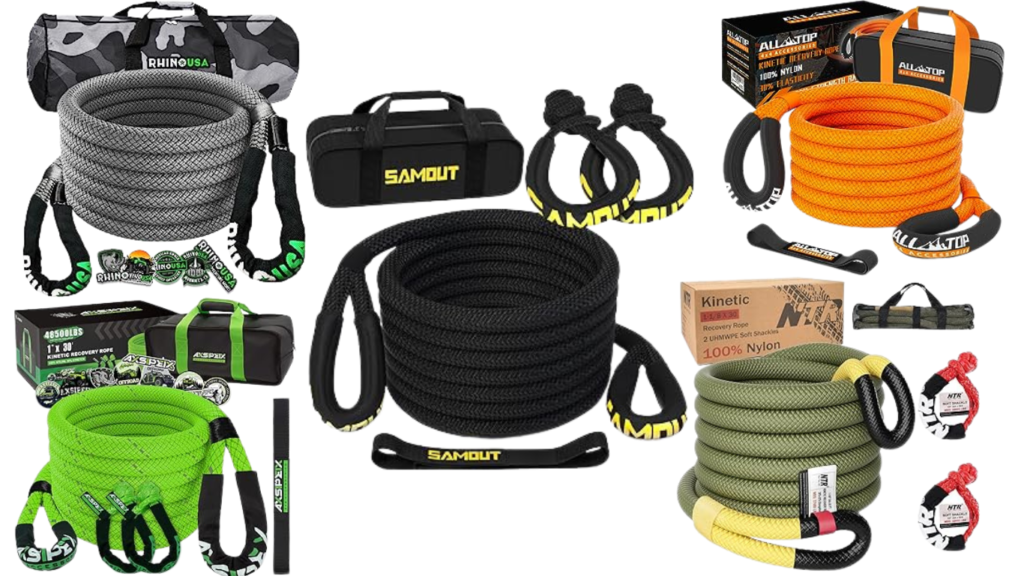Hello, adventure seekers and off-road enthusiasts! Today, I’m diving into a topic that’s crucial for anyone who loves exploring the great outdoors with their vehicle. It’s all about kinetic recovery ropes—a vital piece of gear that can save the day when you or a buddy get stuck. Let’s break down what these ropes are, why they’re important, and the pros and cons of having them in your off-road toolkit. I promise to keep it fun, informative, and easy to understand, so buckle up, and let’s get started!

What Are Kinetic Recovery Ropes?
Imagine you’re out in the wilderness, cruising through mud, sand, or snow, and suddenly, your vehicle gets stuck. No matter how much you try, the wheels just spin, digging you deeper. That’s where a kinetic recovery rope comes into play. Unlike regular tow ropes, kinetic recovery ropes stretch and snap back, using the power of kinetic energy to pull your vehicle out. Think of it like a giant rubber band that you attach between two vehicles. When the rescue vehicle accelerates, the rope stretches, and as it snaps back, it gently yanks the stuck vehicle free. It’s a smoother, more efficient way to get unstuck compared to traditional methods.
Why Are Kinetic Recovery Ropes Important?
Safety First:
First and foremost, safety. Getting stuck in a remote location can be more than just an inconvenience; it can be downright dangerous. Kinetic recovery ropes make the rescue process much safer and less stressful. Because they’re designed to stretch, they reduce the shock load on both vehicles, minimizing the risk of damage or accidents during the recovery process.
Efficiency and Reliability:
These ropes are not just about safety; they’re also about efficiency. They can stretch up to 30% of their length, storing energy that helps pull the stuck vehicle out more effectively. This means less strain on both the vehicles and the people involved in the recovery, making the process faster and more reliable.
The Pros of Kinetic Recovery Ropes
- Thanks to the elastic properties, these ropes reduce the sudden tugs you’d get with a traditional rope, decreasing the likelihood of damaging vehicles.
- Whether you’re stuck in mud, sand, snow, or a ditch, kinetic ropes are designed to handle a wide range of situations.
- Made from high-quality, abrasion-resistant materials, these ropes are built to last and withstand harsh conditions.
- You don’t need to be a professional to use a kinetic recovery rope. With basic knowledge, anyone can perform a safe recovery.
The Cons of Kinetic Recovery Ropes
- Quality comes at a price, and kinetic recovery ropes are generally more expensive than traditional tow straps. However, the investment is worth it for the added safety and efficiency.
- To ensure they last, these ropes require proper care. They need to be cleaned, dried, and stored correctly to prevent damage.
- Although they’re relatively easy to use, there’s still a learning curve. Users must understand how to safely attach the rope and perform the recovery to avoid accidents.
Choosing the Right Kinetic Recovery Rope
When selecting a kinetic recovery rope, consider the weight of your vehicle and the conditions you’ll likely encounter. Ropes come in various lengths and strengths, so it’s essential to pick one that matches your needs. Also, look for ropes made from high-quality materials with good reviews from other off-roaders.
| Diameters | |
| 1/2 inch (12.7 mm): | Suitable for ATVs, UTVs, and small vehicles. Typically, these ropes are for lighter loads. |
| 3/4 inch (19 mm): | Ideal for lighter trucks, Jeeps, and SUVs. This size is a good balance between strength and flexibility. |
| 7/8 inch (22 mm) | A versatile option for medium-sized vehicles, including most 4x4s and off-road capable trucks. |
| 1 inch (25.4 mm): | Designed for heavier trucks, SUVs, and vehicles with moderate to heavy loads. |
| 1-1/4 inches (31.75 mm): | Suitable for large trucks, commercial vehicles, and heavily loaded vehicles. |
| 1-1/2 inches (38.1 mm): | For very heavy applications, including commercial and military vehicles. |
| Lengths | |
| 20 feet (6 meters): | A common length for most off-road recovery situations, offering enough stretch for effective kinetic energy transfer. |
| 25 feet (7.6 meters): | It provides a bit more length for situations where vehicles need extra distance between them, which is useful in muddy or slippery conditions |
| 30 feet (9.1 meters): | Ideal for larger vehicles or when a greater distance is required between the stuck vehicle and the rescue vehicle. |
| 40 feet (12.2 meters): | For specialized situations requiring significant distance, such as commercial or heavy-duty recoveries. |
Tips for Safe Recovery
- – Always wear gloves and protective gear when handling the ropes.
- – Ensure all bystanders are at a safe distance during the recovery process.
- – Check the rope for damage before and after use.
- – Follow the manufacturer’s instructions for attaching and using the rope.
Conclusion
Kinetic recovery ropes are a game-changer for off-road adventures. They offer a safer, more efficient way to get unstuck, minimizing the risk of damage and ensuring you can keep exploring with confidence. While there are some cons, like the cost and maintenance, the benefits far outweigh them, making these ropes a must-have in your off-road toolkit.
So, the next time you’re planning an off-road adventure, make sure a kinetic recovery rope is part of your gear. It could be the difference between a minor setback and a major ordeal. Stay safe, have fun, and keep exploring the great outdoors!
Remember, the key to a successful recovery is not just having the right equipment but knowing how to use it safely and effectively. Happy Trails!